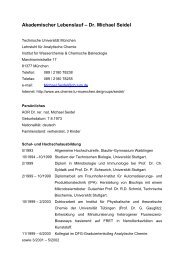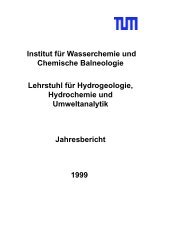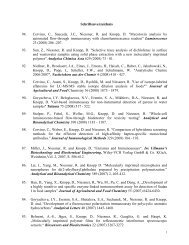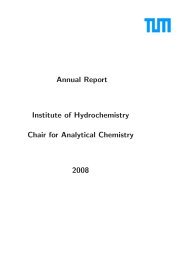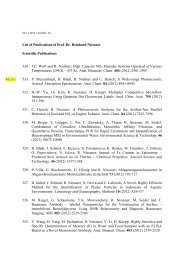IWC Annual Report 2003 - Institut für Wasserchemie und chemische ...
IWC Annual Report 2003 - Institut für Wasserchemie und chemische ...
IWC Annual Report 2003 - Institut für Wasserchemie und chemische ...
You also want an ePaper? Increase the reach of your titles
YUMPU automatically turns print PDFs into web optimized ePapers that Google loves.
Dark chamber<br />
with flow cell<br />
CCD camera<br />
14<br />
Lens<br />
Syringe pumps with sample, antibody<br />
solutions and substrate and washing buffer<br />
1.3 Bioanalytics II<br />
1.3.1 Development of a Biosensor for the Rapid and Simultaneous Detection of<br />
Antibiotics in Milk<br />
F<strong>und</strong>ing: Forschungskreis der Ernährungsindustrie, FEI<br />
Cooperation: LMU Munich (Prof. Märtlbauer)<br />
The presence of antibiotic residues in milk due to improper use can lead to allergic<br />
reactions and the harm of the intestinal flora. There is also concern about increasing<br />
bacterial resistance to antibiotics. In the dairy industry, contaminated milk can result<br />
in the production problems of cultured products (yoghurt and cheese) due to the<br />
inhibition of starter cultures causing significant economic losses.<br />
Out<br />
Sample loop<br />
Chip with microarray<br />
Flow cell<br />
Laptop<br />
In<br />
For consumer protection, regulatory authorities have established<br />
residue limits (MRL) for several antibiotics in bovine milk<br />
(EC Regulation 2377/90). Microbial inhibition (e.g., agar diffusion)<br />
assays are commonly used as screening tests. One disadvantage<br />
of these methods is the duration of about three hours.<br />
Usually the results are obtained, when the milk is already in<br />
production. For this reason dairies use quick tests which can<br />
detect the frequently used β-lactam antibiotics before the milk<br />
is pumped out of the dairy van to avoid troubles with fermentation<br />
steps in the milk processing. Other antibiotic groups than<br />
the β-lactams can not be determined with these tests. Furthermore,<br />
the dairy has to dispose the whole milk of a diary van<br />
in case of a positive test result. To avoid the contamination of<br />
the already collected milk a sensor would be very helpful, which<br />
enables the rapid detection of all relevant antibiotics before the<br />
milk is pumped into the diary van.<br />
The basis for this sensor is the PASA system (Parallel Affinity Sensor Array) which<br />
allows the transfer of an indirect ELISA onto a biochip. Analyte molecules are immobilized<br />
as haptens in an array of spots on a biochip. The glass chip is silanized<br />
to obtain reactive epoxy groups on the surface. Hapten protein conjugates can bind<br />
covalently and by adsorption. The spots are created by a non-contact spotting system<br />
with a piezo pump. The diameter of the spots is about 350 µm with a spot distance of<br />
0.6 mm. The disposable chip is inserted in a flow cell of about 100 µL volume, where<br />
all incubations and reactions are carried out automatically.<br />
At present the simultaneous detection of the following analytes is possible in whole<br />
milk (detection limits and MRLs in brackets): Penicillin G (3.3 µg/L, MRL: 4 µg/L),<br />
cloxacillin (0.29 µg/L, MRL: 30 µg/L), cephapirin (0.12 µg/L, MRL: 60 µg/L), sulfadiazine<br />
(3.49 µg/L, MRL: 100 µg/L), sulfamethazine (4.93 µg/L, MRL: 100 µg/L),<br />
streptomycin (5.1 µg/L, MRL: 200 µg/L), gentamicin (12.1 µg/L, MRL: 100 µg/L),<br />
neomycin (31.8 µg/L, MRL: 1500 µg/L), erythromycin (0.36 µg/L, MRL: 40 µg/L)<br />
and tylosin (0.95 µg/L, MRL: 50 µg/L). Penicillin G could be detected at the maximum<br />
residue limit (MRL), the detection limits for all other analytes were far below<br />
the respective MRLs. The tests require no sample preparation and can be carried<br />
out within 4 minutes 50 seconds. For the quantification of samples first a calibration<br />
with 5 chips is performed. The test of samples each spiked with five analytes could be<br />
demonstrated successfully. Different fat contents of the milk had no influence on the<br />
results.<br />
(B. Knecht)



